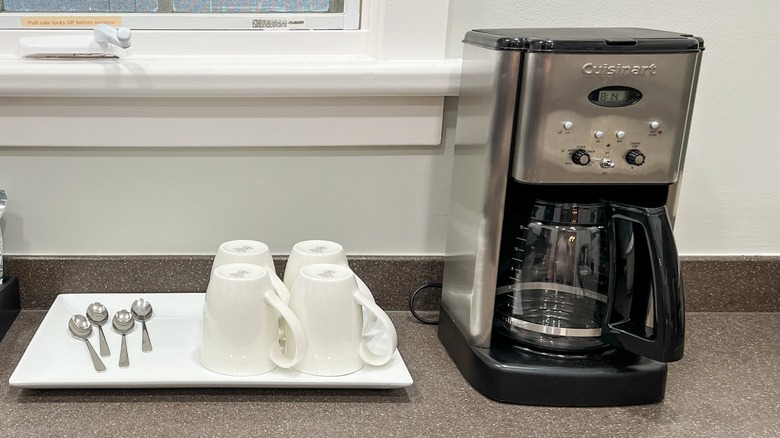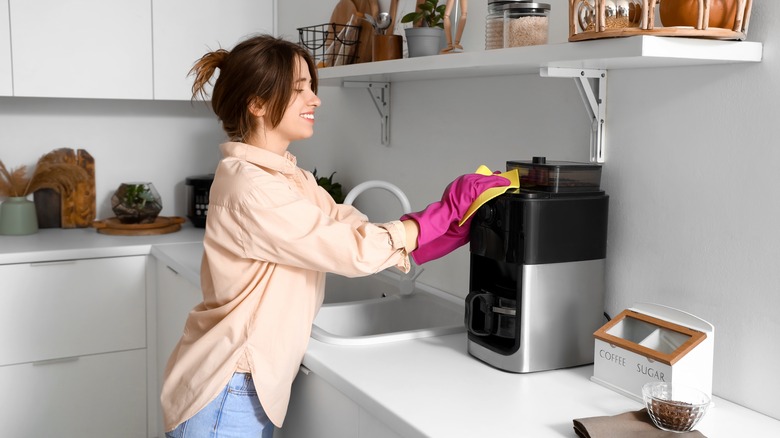The Best Way To Clean A Cuisinart Coffee Maker
Waking up in the morning and beelining for your Cuisinart coffee maker might be a sacred part of your daily ritual. After all, what better way to remove the cobwebs from your brain than jolting it awake with a fresh dose of caffeine? However, things come to a head when your morning coffee starts tasting a little less delicious every day (the horror!). Before you make the executive decision to switch brands, take a minute to recall the last time you cleaned and descaled the coffee maker. If it has been a while, chances are a deep cleaning session using distilled white vinegar and water is in order.
Coffee contains oil, and when you brew it in the maker, this natural oil builds on the insides of the carafe, filter baskets, and brew chambers. Over time, the buildup will ruin the drink's taste before eventually clogging the nifty machine. Plus, the occasional splash will lead to unsightly stains on the appliance. Cleaning the appliance will take care of these issues, but there's another problem that needs to be addressed: the mineral buildup inside. Because of minerals like magnesium and calcium in the water, the buildup slowly deposits on the appliance's hot plate, which presents two problems.
First, a clogged hot plate will adversely impact the coffee's flavor. Worse, the maker won't dispense a piping hot drink anymore. If you find yourself in a similar situation, here's the best way to clean and descale your Cuisinart coffee maker.
How to clean a Cuisinart coffee maker
First things first, turn off your Cuisinart coffee maker and unplug it from the electrical outlet to prevent accidents. Let the machine cool before dampening (it shouldn't be soaking wet) a clean microfiber cloth and running it over the exterior. If you encounter a few stubborn coffee stains, combine a few drops of mild dish soap with water in a small bowl. Don't add soap with a heavy hand, or you'll be left with streaks and stains. Additionally, steer clear of abrasive scouring pads to avoid damaging the finish. Dip a fresh microfiber cloth in the solution and wring out the excess prior to wiping the exterior.
Follow this up by lifting the appliance's lid to remove the coffee filter and used coffee grounds. You can either store used coffee grounds to reuse around your home and garden or simply dump them out. As for the filter, give it a cleansing bath by combining mild dish soap with warm water. Alternatively, place it on the top rack of your dishwasher.
Follow a similar cleaning process for the coffee carafe after ensuring it is empty. Once the filter and carafe look spotless, dry them with a lint-free cloth before returning them to their designated spot. While the oils in coffee build up over time, following this simple cleaning routine on a daily basis will minimize the issue, so you can always enjoy a fresh pot of coffee.
How to descale a Cuisinart coffee maker
Although cleaning your coffee maker is necessary to maintain the rich flavor of the drink, descaling it is equally important. But don't worry; you don't have to descale the appliance every day. A rule of thumb is to descale the maker every three to six months, depending on how often you use the machine and the level of minerals present in the water you pour within. The first step is to remove the charcoal-based water filter and set it aside. You also want to clean the accompanying carafe. Now, arm yourself with distilled white vinegar and some water. While you may want to hold off descaling certain coffee makers with vinegar, Cuisinart encourages its use in descaling.
Fill the carafe with water and vinegar in a 2:1 ratio and pour it inside the reservoir. Put the lid back on the carafe, place it in its designated spot, and press the "clean" (or brew) button. The button will start flashing red, meaning the self-cleaning cycle has started, so give it some time to descale itself. When you hear five beeps, it means the process is completed, so dump the deposited cleaning solution in the carafe. If the clean button remains on after you hear the beeps, repeat the steps to further descale its insides. Otherwise, fill it with fresh water and follow a similar process to flush out the lingering vinegar inside the appliance. Finish off by putting the water filter back.

